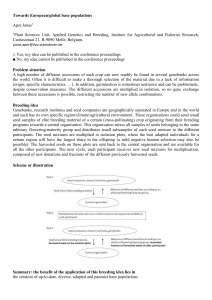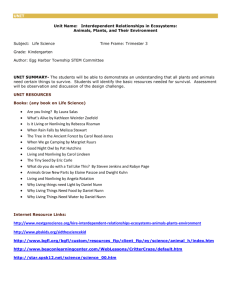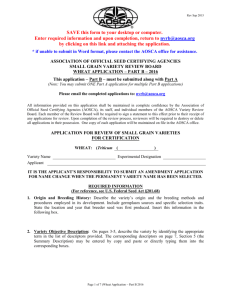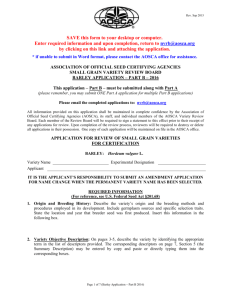2016 Small Grains Application - Part B - Triticale
advertisement
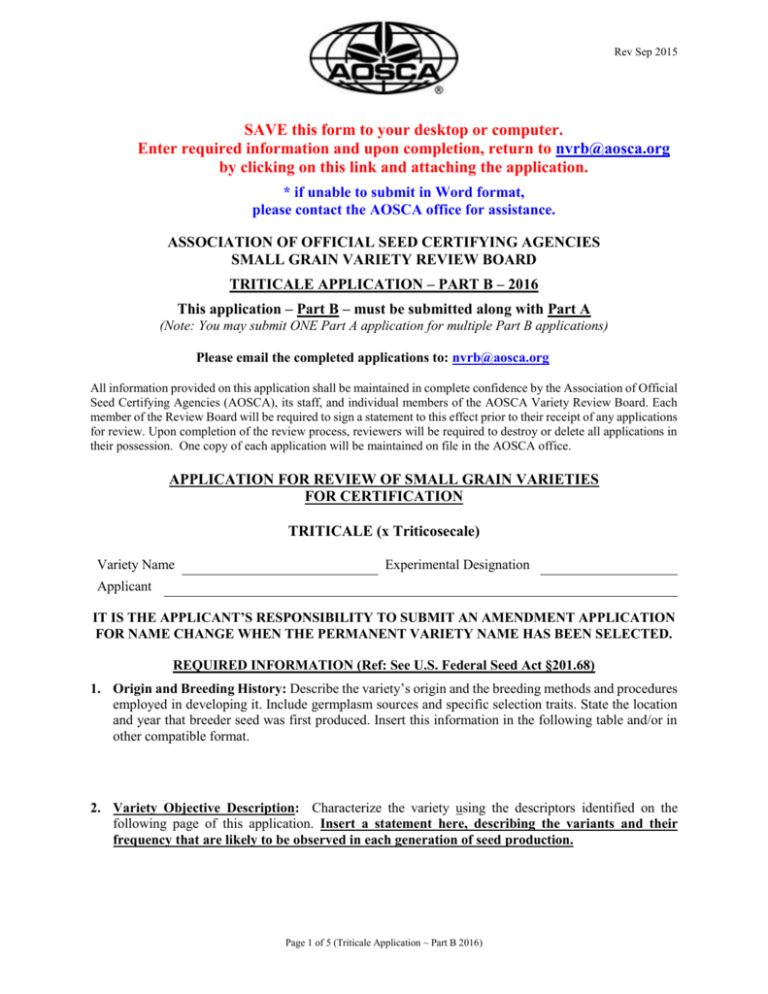
Rev Sep 2015 SAVE this form to your desktop or computer. Enter required information and upon completion, return to nvrb@aosca.org by clicking on this link and attaching the application. * if unable to submit in Word format, please contact the AOSCA office for assistance. ASSOCIATION OF OFFICIAL SEED CERTIFYING AGENCIES SMALL GRAIN VARIETY REVIEW BOARD TRITICALE APPLICATION – PART B – 2016 This application – Part B – must be submitted along with Part A (Note: You may submit ONE Part A application for multiple Part B applications) Please email the completed applications to: nvrb@aosca.org All information provided on this application shall be maintained in complete confidence by the Association of Official Seed Certifying Agencies (AOSCA), its staff, and individual members of the AOSCA Variety Review Board. Each member of the Review Board will be required to sign a statement to this effect prior to their receipt of any applications for review. Upon completion of the review process, reviewers will be required to destroy or delete all applications in their possession. One copy of each application will be maintained on file in the AOSCA office. APPLICATION FOR REVIEW OF SMALL GRAIN VARIETIES FOR CERTIFICATION TRITICALE (x Triticosecale) Variety Name Experimental Designation Applicant IT IS THE APPLICANT’S RESPONSIBILITY TO SUBMIT AN AMENDMENT APPLICATION FOR NAME CHANGE WHEN THE PERMANENT VARIETY NAME HAS BEEN SELECTED. REQUIRED INFORMATION (Ref: See U.S. Federal Seed Act §201.68) 1. Origin and Breeding History: Describe the variety’s origin and the breeding methods and procedures employed in developing it. Include germplasm sources and specific selection traits. State the location and year that breeder seed was first produced. Insert this information in the following table and/or in other compatible format. 2. Variety Objective Description: Characterize the variety using the descriptors identified on the following page of this application. Insert a statement here, describing the variants and their frequency that are likely to be observed in each generation of seed production. Page 1 of 5 (Triticale Application ~ Part B 2016) Rev Sep 2015 3. Supporting Information: Provide data to characterize the variety in the following areas: a) Forage and/or grain yield and other agronomic responses obtained from test locations that support the area of adaptation. b) Disease and insect resistance reactions and the testing conditions used to determine them (i.e., field, greenhouse, or laboratory). State specific races or strains of organisms, if known. c) Any other relevant identifying factors, such as forage quality and processing qualities. Provide separate data from at least two years and two locations in the area of adaptation for agronomic traits, as appropriate. Include at least one recognized check variety for grain and/or forage yield and milling and baking traits. Include and identify susceptible and resistant checks for comparative pest reactions. Present all data in well-constructed tables appended to the end of this application. Number the tables and indicate where the data were collected. Include captions or footnotes as necessary to clearly explain the nature and units of the headers and units of measurements. Provide a measure of statistical significance (P = .05) and the experimental variance for each location-year or test. 4. Summary Description: Provide a concise, single page description of the variety for AOSCA to publish for use by official seed certifying agencies. All claims must be supported by data. Use the instructions and template located at the end of this application. Page 2 of 5 (Triticale Application ~ Part B 2016) Rev Sep 2015 VARIETY OBJECTIVE DESCRIPTION TRITICALE (X Triticosecale) Variety Name: Experimental Designation: Instructions: Select one (1) term for each numbered descriptor by inserting an X in the adjacent cell. 1. PLOIDY: Hexaploid (2N = 42) Octoploid (2N = ) Other (specify) 2. GROWTH HABIT: Spring Intermediate Winter 3. PHOTOPERIOD REACTION: Insensitive Sensitive 4. WINTERHARDINESS: Low 5. MATURITY: 6. HEIGHT: Med. low Very early Dwarf Early Yellow-green 8. STEM ANTHOCYANIN: Absent None Slight Wavy 14. SPIKE AWNEDNESS: 15. AWN COLOR: Mid-dense Fusiform Green Blue-green Heavy Twisted Re-curved Present Drooping Dense Oblong Awnless White Tall Other (specify) Not twisted Erect Waxy bloom : Absent 13. SPIKE SHAPE: Mid-tall Moderate 11. FLAG LEAF AT BOOT: Lax Very Late Present Straight 12. SPIKE DENSITY: High Late Short 7. PLANT COLOR AT BOOT STAGE: 10. NECK SHAPE: Med. high Mid-season Semi-dwarf 9. NECK HAIRINESS: Medium Clavate Elliptical Apically Awnletted Yellow Tan Other (specify) Awnletted Brown Awned Black GLUMES AT MATURITY 16. 17. 18. 19. 20. 21. PUBESCENCE: COLOR: LENGTH: WIDTH: SHOULDER: BEAK: Glabrous White Short Narrow Wanting Obtuse 22. COLEOPTILE COLOR: SEED 23. SHAPE: 24. SMOOTHNESS: 25. BRUSH AREA: 26. BRUSH LENGTH: 27. COLOR: 28. RELATIVE SIZE: Ovate Smooth Small Short White Small Slightly pubescent Yellow Tan Mid-long Long Mid-wide Wide Oblique Rounded Acute Acuminate White Green Pubescent Brown Square Black Elevated Apiculate Purple Oval Elliptical Slightly wrinkled Wrinkled Mid-size Large Mid-long Long Amber Red Purple Black Med-small Medium Med-large Page 3 of 5 (Triticale Application ~ Part B 2016) Other (specify) Large Rev Sep 2015 Summary Description Format Provide a concise, single page description of the variety on the next page for AOSCA to publish for use by official seed certifying agencies. All claims must be supported by data. You must use the categories described below, using COMPLETE SENTENCES. Insert your text in the blank cell next to the item number. PLEASE DELETE THIS INSTRUCTION PAGE WHEN SUBMITTING AN APPLICATION. 1. The name of the variety, including its experimental designation, its market class, and the identity of the developer and/or owner. Example: OurTrit (Experimental no.) is a hard red winter wheat developed by ABC Breeding Company. 2. A summary statement of the selection criteria and breeding procedures that were previously described. Confidential business information is not required. Example: OurTrit was selected for high spike density, resistance to stripe rust, and high falling number using the single seed descent method. 3. Area of probable adaptation, testing locations, and primary purpose for which the variety will be used. Example: OurTrit was tested in western Oklahoma and is well-adapted as to be a grazingtolerant bread wheat in the irrigated and dryland production areas of the southern High Plains. 4. A statement relative to the claims made (supported by evidence presented in this application) about the variety’s agronomic disease and insect resistance. Example: OurTrit is possesses excellent lodging resistance, is resistant to races 1, 2, 3 of stem rust and moderately resistant to Hessian fly. 5. Provide a detailed description of morphological, physiological and other identifying characteristics by selecting options presented in the Variety Objective Description section and typing or pasting the selections into the table on the Summary Description format page. Include a description of variants and their frequency at the end of the section. 6. State the certified seed classes to be recognized, the party responsible for maintaining the variety, and procedure(s) adopted for maintaining seed stocks, with limitations, if any. If applicable, state whether the variety may be subject to collection of a royalty fee by certifying agencies and whether any kind of stewardship or licensing agreement is required that would affect certifying agency activities, such as trait-verification by molecular or bioassay testing. Example: Recognized classes of OurTrit are breeder, foundation, registered, and certified. ABC Breeding Company will maintain the variety by the head-row purification method to produce breeder seed as needed and all foundation seed. No royalty fees or licensing agreements are anticipated. 7. State the likely date that certified seed will first be offered for sale. Example: Certified seed of OurTrit will likely be available for planting in fall of 2015 8. State whether or not application will be submitted for protection under the U.S. Plant Variety Protection Act and, if appropriate, whether or not the “Certification Option” will be elected (to be sold by variety name only as a class of certified seed). If application for PVP is not planned, state whether relevant descriptive data (morphological only) can be supplied to the PVP database. Examples: Application for PVP is anticipated with the option that OurTrit can be sold by variety name only as a class of certified seed. OR: Application for PVP is not planned and descriptive data (may) (may not) be supplied to the PVP database. 9. State whether or not certified seed production acreage can be published by AOSCA and certifying agencies. Examples: Certified seed production acreage (may) (is not to) be published by AOSCA and individual certifying agencies Page 4 of 5 (Triticale Application ~ Part B 2016) Rev Sep 2015 Triticale Insert Variety Name Here Insert Experimental Designation Name(s) Here 1. 2. 3. 4 5. Identifying characteristics – insert the appropriate descriptive term from the Objective Description 1. Ploidy: 2. Growth Habit: 3. Photoperiod Reaction: 4. Winterhardiness: 5. Maturity: 6. Height: 7. Plant Color at Boot Stage: 8. Stem Anthocyanin: 9. Neck Hairiness: 10. Neck Shape: 11. Flag Leaf at Boot: 12. Spike Density: 13. Spike Shape: 14. Spike Awnedness: 15. Awn Color: 16. Glume Pubescence: 17. Glume Color: 18. Glume Length: 19. Glume Width: 20. Glume Shoulder Shape: 21. Glume Beak Shape: 22. Coleoptile Color: 23. Seed Shape: 24. Seed Smoothness: 25. Seed Brush Area: 26. Seed Brush Length: 27. Seed Color: 28. Seed Relative Size: Unique physiological/biochemical traits: Variants and Frequency: 6. 7. 8. 9. Page 5 of 5 (Triticale Application ~ Part B 2016)




